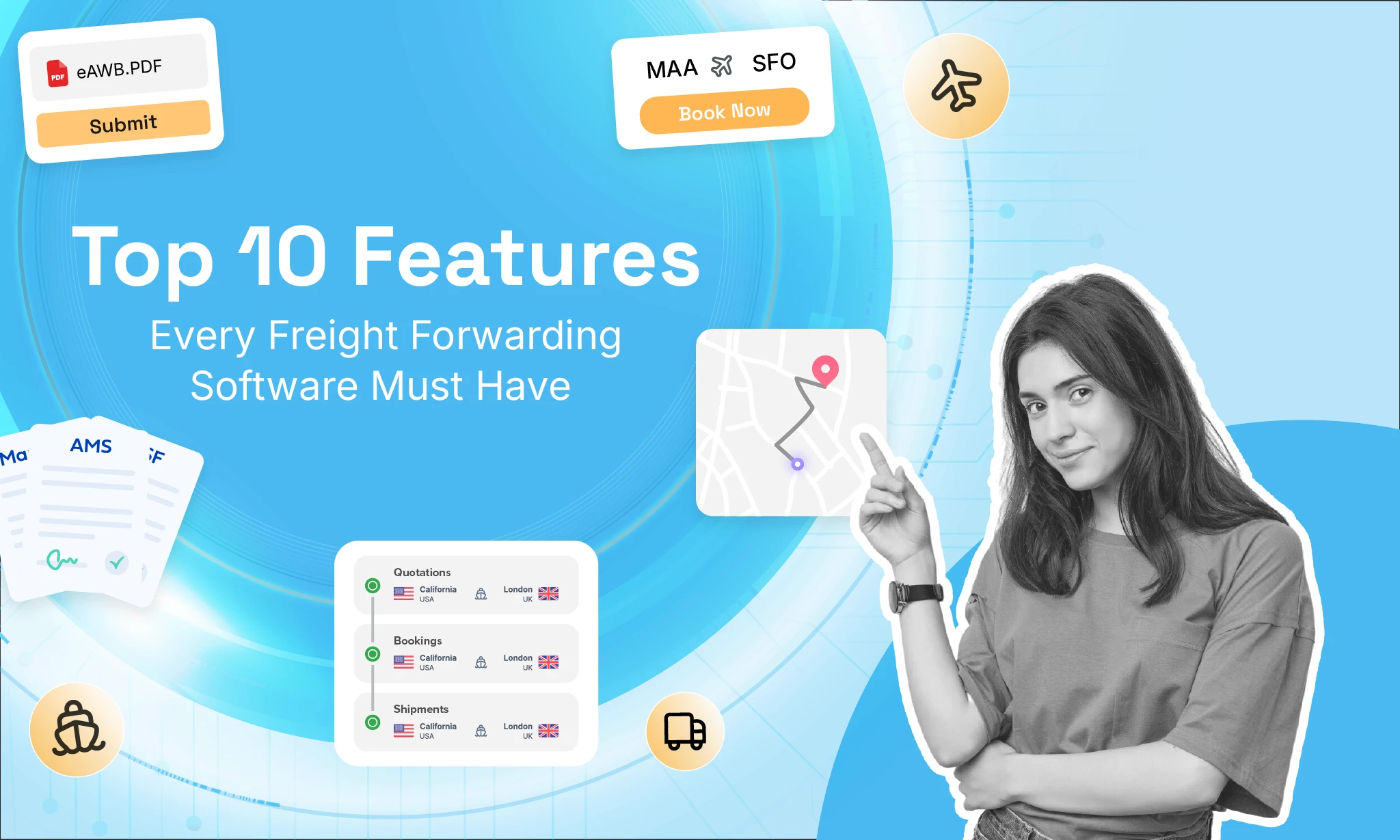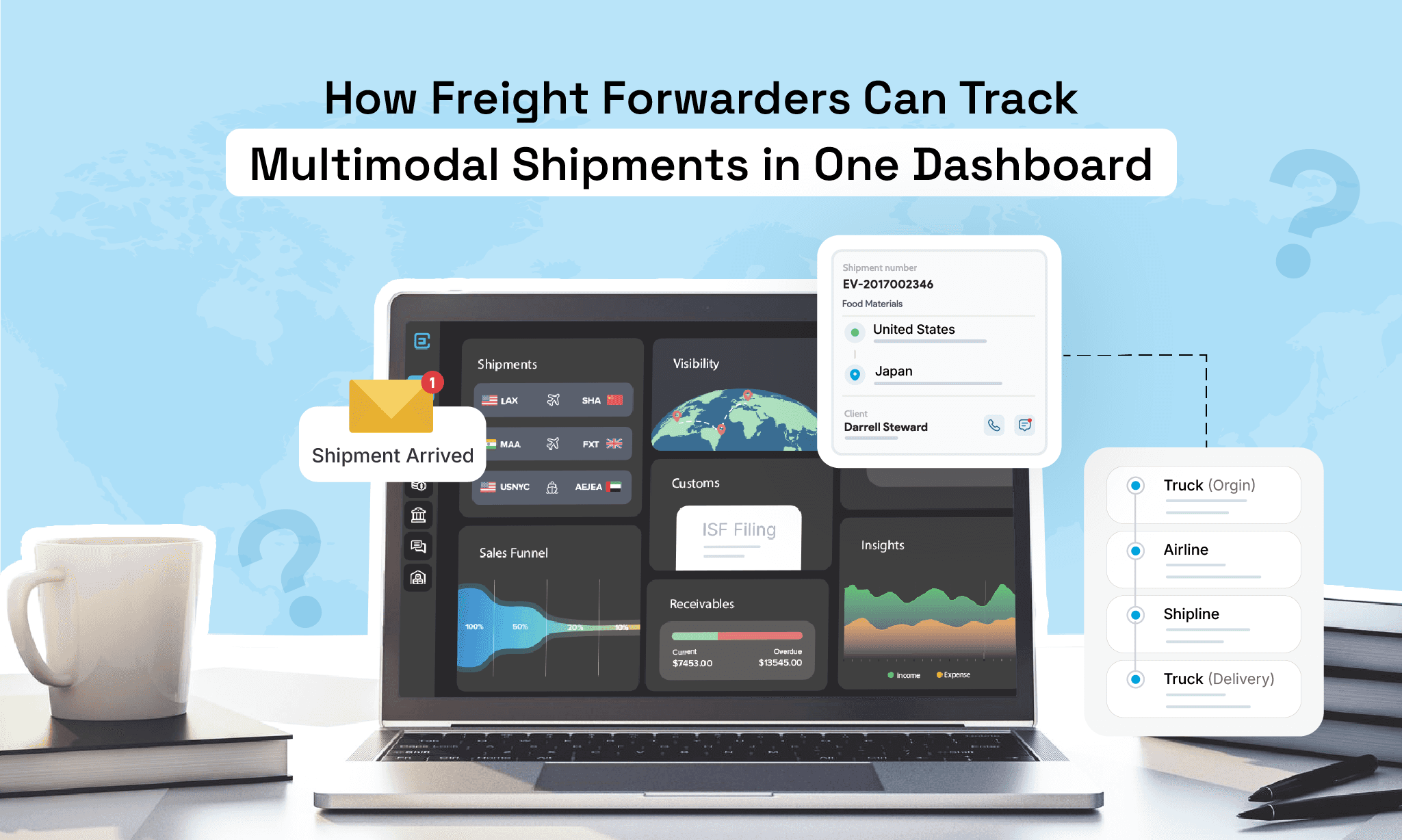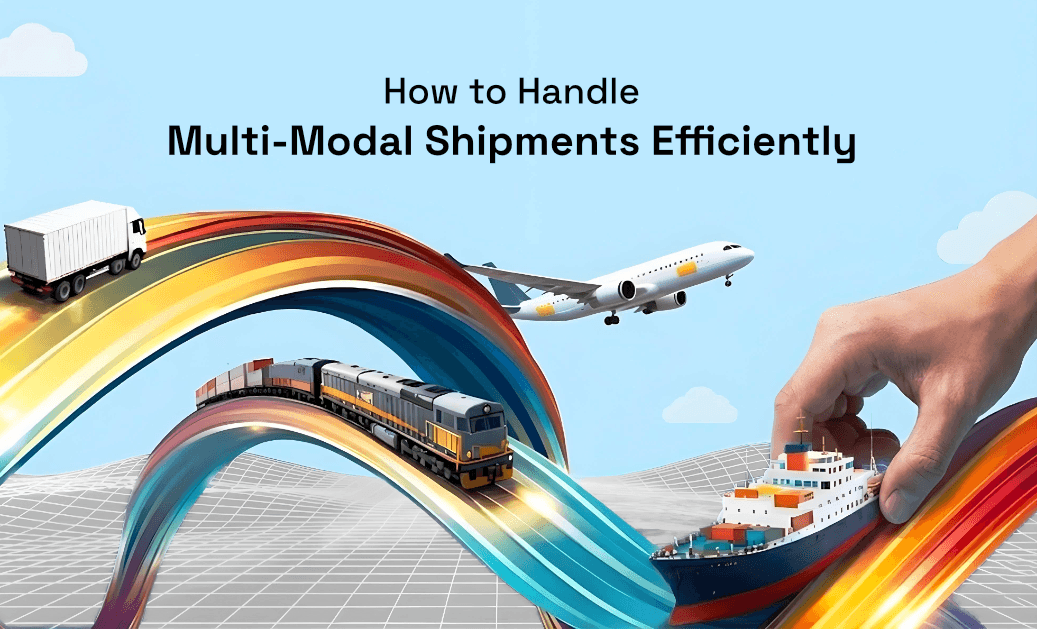Freight Quote Automation: Automating Quotation Management
Author:
Dharshini Balamurugan
Published On:
Sep 5, 2025
Updated On:
Sep 5, 2025
1 min read
In freight forwarding, time is everything. From managing carrier rates to responding to customer inquiries, even a small delay in sending out quotes can mean lost deals and missed revenue.
Traditionally, quoting has been a slow, manual process involving countless emails, spreadsheets, and back-and-forth communication. It demands a significant amount of effort spent on data collection and formatting, tasks that take time away from more strategic, sales-driven activities.
But with the rise of freight quote automation and sales tools, forwarders can now simplify this critical step. By removing tedious workflows and reducing reliance on manual input, automation empowers teams to respond faster, work smarter, and focus on what truly matters: building strong customer relationships and delivering great service.
In this blog, we’ll explore why automated quotation management is a game-changer for freight forwarders, the advantages it brings, and how to get started with the right tools and approach.
Why Freight Quote Management Needs Automation
1. The Traditional Quoting Problem
Manual quoting is prone to errors and inefficiencies. Teams often juggle multiple rate sheets, manually calculate surcharges, and cross-check carrier rates, all while trying to respond quickly to customer inquiries. These steps involve numerous administrative tasks, manual tasks, and repetitive tasks that slow down the quoting process and increase the risk of errors. This process is not only time-intensive but also leaves room for costly mistakes such as incorrect pricing or missed margins.
2. Rising Customer Expectations
Customers now expect instant quotes, just like they receive instant shipping estimates from e-commerce giants. The logistics industry can no longer afford to spend hours, or even days, compiling quotes when competitors are offering faster, automated solutions.
3. The Competitive Edge
Automation ensures that forwarders can generate accurate, competitive, and real-time quotes at lightning speed. This isn’t just about saving time, it’s about staying ahead of competitors who still rely on outdated processes. By increasing efficiency through automation, forwarders can enable faster, more accurate quoting, which ultimately leads to more sales.
What is Freight Quote Automation?
Freight quote automation is the use of digital tools and software to generate, manage, and send freight quotes automatically. These systems pull rates from carriers, calculate all applicable charges such as fuel surcharges, customs fees, taxes, and deliver a polished, accurate quote to the customer, often within seconds.
Unlike manual methods, automation doesn’t just save time; it also improves accuracy, integrates with CRM systems, and tracks all quotes in one centralized dashboard.
Modern freight quote automation solutions often include workflow automation features, enabling users to automate tasks such as lead management, deal progression, and order processing throughout the sales process. These systems can function as a sales automation platform by integrating quoting with broader sales and customer management workflows.
Benefits of Automating Quotation Management

1. Faster Response Times
With automation, quotes can be generated in just a few clicks. No more scrambling through spreadsheets or waiting for manual calculations. This speed gives you a competitive edge, especially when clients are comparing multiple forwarders and want answers fast.
2. Improved Accuracy
Manual quotes are prone to human error, missing surcharges, using outdated rates, or applying the wrong markup. Automation pulls live rates and standardizes calculations, helping you avoid mistakes that could eat into your margins or upset clients.
3. Increased Productivity
Automation frees up your sales team including sales team members, sales representatives, and sales professionals from repetitive quoting tasks. Automation can automate repetitive sales tasks, automate repetitive tasks, and is effective for automating sales tasks, allowing the team to focus on higher-value activities. Instead of spending hours drafting proposals, they can focus on building client relationships, handling complex requests, and closing more deals.
4. Better Customer Experience
Clients love fast and accurate service. When they receive a clear, professional quote within minutes, it sets a strong first impression. Automated quoting helps you be responsive, consistent, and trustworthy, which keeps customers coming back. This not only improves customer experience but also leads to improved customer satisfaction and helps build stronger customer relationships.
5. Centralized Quote Tracking
Every quote whether accepted, declined, or revised is stored in one place. Automation tools can generate sales reports, performance reports, and support sales reporting by allowing users to generate custom reports on quote activity and outcomes. This makes it easy to review past quotes, track trends, follow up on open leads, and understand what’s working and what’s not in your sales process.
6. Scalability
As your customer base grows, so does the volume of quote requests. Automation helps you handle this growth without added stress. Whether you’re managing 10 quotes a day or 100, the system works at the same speed and accuracy.
Must-Have Features in Quoting Tools

Freight quote automation is a way to streamline your process and plays a crucial role in providing the most accurate quotes to your customers. The best freight quote automation solutions often function as a sales automation CRM, sales automation tool, or sales automation platform, and are part of a broader suite of sales software and sales tools that streamline the quoting and sales process. With that in mind, choosing a freight quote automation tool must carry the following features for the best-case scenario
Carrier Rate Integration
Look for a tool that connects directly with carrier APIs or allows you to upload rate sheets. This gives you real-time access to the latest freight rates, helping you quote faster and more accurately without switching between platforms.
Margin Control
Your quoting tool should allow you to set default markups, apply discounts, and adjust margins based on the customer, route, or mode. This ensures every quote is profitable while still staying competitive.
CRM and Sales Automation
Integration with your CRM, along with automated contact management and advanced CRM software features, makes it easy to manage leads, track customer conversations, and send quotes directly from the sales pipeline.
These integrations help maintain up-to-date contact records and track customer interactions throughout the sales process, ensuring your team always has accurate information to enhance engagement and decision-making. Automation features like follow-up reminders or quote status updates can help close deals faster.
Multi-modal Support
Freight rarely sticks to just one mode. Your automation tool should support air, ocean, and road freight quotes, so you can handle any request, no matter how complex.
Customizable Templates
Branded, professional quote templates show your clients that you mean business. Look for a solution that lets you customize the design, format, and content—so every quote looks polished and consistent.
Analytics & Reporting
Understand how your quotes are performing with built-in analytics that leverage sales data. Track your win/loss ratio, identify your top-performing routes, and see which sales reps are closing the most. Data like this can help you improve pricing strategies and optimize your sales process, as these analytics tools allow teams to analyze data and ensure everyone is working from the same data for better decision-making.
Sales Automation's Role in Freight Forwarding
Freight forwarding is both an operational and sales-driven industry. Sales teams, along with the broader sales organization and the dedicated sales operations team, spend a lot of time following up on quotes, managing prospects, and tracking leads. Here’s where sales automation complements quote automation. Implementing a clear sales strategy is essential for maximizing the benefits of sales automation in freight forwarding.
Automated Follow-Ups
Sending out a quote is just the first step often, the real value comes from what happens next. Many potential customers don’t respond right away, not because they’re not interested, but because they’re busy or distracted. Manually following up on every quote can be time-consuming and inconsistent.
With automation, you can set up timely and personalized follow-up emails to go out automatically if a customer hasn’t responded within a certain timeframe. Sales email automation features can schedule, personalize, and track follow-up communications, making it easier to improve response rates and overall efficiency. These gentle nudges help keep your quote top of mind and increase the chances of conversion without requiring manual input from your sales team.
You can also customize follow-ups based on the quote amount, type of service, or customer history for more relevant communication.
Lead Scoring
Not all leads are created equal. Some are just browsing, while others are ready to ship and have high revenue potential. Without a way to prioritize, your sales team might waste valuable time chasing cold leads while hot ones go cold. Automation tools can streamline lead generation and help generate leads more efficiently, ensuring your team spends time on the most promising prospects.
Lead scoring solves this by assigning a score to each lead based on criteria like how quickly they responded to a quote, how often they engage with your emails, their shipment history, or estimated revenue. These tools help qualify leads and route qualified leads to the right salespeople for faster follow-up.
High-scoring leads can be fast-tracked for follow-up, while lower-priority leads can be nurtured through longer-term campaigns. This allows your team to focus energy where it matters most, on closing deals that make an impact.
Customer Portals
Today’s freight customers prefer self-service options. Instead of calling or emailing for every small request, they want the ability to check prices, submit shipment details, or track quotes on their own.
A customer portal makes that possible. With a secure login, clients can request quotes, review past shipments, approve proposals, and even book jobs directly, 24/7, from anywhere. This not only improves their experience but also reduces the workload for your team. It puts more control in the hands of your customers while ensuring your team stays focused on more complex or high-value tasks.
Pipeline Visibility
To run an efficient sales operation, you need more than just a list of quotes, you need a clear view of your entire sales pipeline.
Where are your deals stuck? How many quotes are pending? Which reps are closing the most business?
With automated quoting systems, every quote is linked to a lead or deal in your CRM or sales dashboard. This gives managers and teams full visibility into the sales pipeline and the sales funnel, allowing you to identify and automate critical tasks at each stage of the sales process, from initial inquiry to closed deal.
You can track status, identify bottlenecks, forecast revenue, and manage team performance with greater confidence. It transforms your quoting process from a reactive task into a proactive, strategic sales driver.
Together, freight quote automation and sales automation create a frictionless sales cycle, from inquiry to booking.
Challenges of Manual Quoting: A Real-World Example
Imagine a forwarder receiving 50 quote requests in a single day. Without automation:
Each quote could take 15–30 minutes to prepare.
Teams might spend 10–12 hours just preparing quotes, leaving little time for customer engagement.
Delayed quotes risk losing clients to competitors who can provide instant responses.
With automation, that same volume of quotes can be prepared in under an hour, freeing up time for revenue-generating activities.
How to Implement Freight Quote Automation
1. Assess Your Current Process
Start by examining how your team currently handles quote generation. Identify common bottlenecks, such as time spent retrieving carrier rates or manually formatting quotes. Understanding where delays or inefficiencies occur will help you decide what to automate first.
2. Choose the Right Platform
Select a quoting solution that integrates well with your existing Transportation Management System (TMS) and Customer Relationship Management (CRM) tools. Make sure the platform supports real-time rate access, branded templates, and automation features. The goal is to find a system that makes your quoting process faster and more reliable.
3. Train Your Team
It’s essential that your team knows how to use the new automation tools effectively. Provide hands-on training sessions and create guides or walkthroughs to help them get familiar with the platform. The more confident your team is, the smoother your transition to automation will be.
4. Start Small, Scale Fast
Instead of trying to automate everything at once, begin with a small set of frequently requested quotes, like your most common trade lanes or services. Once your team is comfortable and you see the results, you can gradually expand automation to other areas of your quoting process.
5. Monitor and Optimize
After automation is in place, keep an eye on performance using the tool’s analytics and reporting features. Track which quotes are winning or losing and analyze why. Use these insights to adjust pricing strategies, improve templates, or fine-tune follow-ups to increase your overall success rate.
Sales and Marketing Alignment in Automated Quotation Management
In today’s fast-paced freight forwarding environment, seamless alignment between sales and marketing is more important than ever, especially when it comes to automated quotation management. When sales teams and marketing teams work from the same set of accurate, up-to-date customer data, pricing, and product information, the entire sales process becomes more efficient and effective.
By integrating sales automation software with marketing automation tools, businesses can ensure that sales reps always have the latest information at their fingertips. This integration allows for the automation of repetitive sales tasks, such as generating quotes, proposals, and contracts, freeing up sales teams to focus on building relationships and closing deals. With automation tools handling the heavy lifting, sales reps can spend more time on high-value activities that drive results.
Effective sales and marketing alignment also means that every customer interaction is informed by a complete view of the customer journey. Marketing automation can nurture leads and deliver qualified prospects directly to the sales team, while sales automation tools ensure that follow-ups, quote generation, and proposal delivery happen quickly and accurately. This not only increases sales productivity but also helps deliver a more personalized customer experience.
Ultimately, when sales and marketing are aligned through automation, businesses can reduce errors, accelerate response times, and increase sales. The result is a streamlined process that empowers sales teams to close more deals and drive revenue growth, all while providing customers with the fast, accurate service they expect.
Measuring the ROI of Quotation Automation
Implementing quotation automation is just the first step, measuring its impact is key to ongoing success. Sales managers and sales operations teams need to track the right metrics to ensure their sales automation system is delivering real value.
Future Trends in Freight Quote Automation
AI-Powered Pricing: Machine learning algorithms that suggest competitive prices based on historical data and market trends.
Dynamic Pricing Models: Real-time adjustments based on capacity, fuel costs, and seasonality.
Chatbot Integration: AI chatbots capable of generating instant quotes through messaging platforms.
Social Media Platforms Integration: Connecting quoting tools with social media platforms enables instant quoting and customer engagement directly through channels like Facebook Messenger or WhatsApp.
Predictive Sales Automation: Automated forecasting for sales teams based on quote conversion rates.
AI-Generated Sales Pitches: Generative AI can automatically create effective sales pitches, helping freight forwarding sales teams save time and improve their outreach efforts.
CargoEZ: Simplifying Freight Quote Automation
Quoting has long been one of the most time-consuming parts of freight forwarding. Delays often stem from scattered rate sheets, manual data entry, and slow follow-ups. Tools like CargoEZ help streamline this process by bringing everything into one platform.
With access to real-time carrier rates, forwarders can generate accurate quotes in seconds—no more digging through emails or spreadsheets. A centralized dashboard keeps all quotes organized and accessible, making it easy to track status and respond quickly.
Once a quote is accepted, it can be converted directly into a shipment, cutting down on repetitive work. Sales teams can also automate follow-ups and prioritize leads, helping them close more deals with less effort.
Automation helps forwarders focus on what really matters: faster response times, better service, and more wins.
Conclusion
Automating quotation management is no longer optional, it’s essential for freight forwarders looking to stay ahead.
Quote automation saves time, minimizes errors, and delivers accurate, lightning-fast responses your customers can count on. It helps you close deals quicker and with confidence. When combined with sales automation, it builds a seamless, modern sales cycle that gives you a competitive edge in today’s fast-paced logistics landscape.
Platforms like CargoEZ bring this automation to life, so your team can focus less on chasing quotes and more on winning business.
Frequently Asked Questions (FAQs)
1. What is freight quote automation, and how does it work?
Freight quote automation uses software to generate accurate freight quotes in real time. It pulls rates from carriers, applies your markups or margins, and sends ready-to-book quotes to your customers automatically.
2. Will it work for all modes- air, ocean, and road?
Yes. Most freight quote automation tools are built to handle multimodal quotes, so you can generate quotes for air, sea, road, or even intermodal shipments within a single platform.
3. Can I customize the quotes with my brand and pricing logic?
Absolutely. You can personalize your quotes with your logo, company colors, and preferred rate logic. You can even build tiered pricing models based on customer type or shipment urgency.
4. How does it help my sales team close deals faster?
It reduces waiting time and helps your team respond instantly to quote requests. With quote templates, automated follow-ups, and instant rate visibility, your sales cycle gets dramatically shorter.
5. Will it integrate with my CRM, TMS, or accounting tool?
Most modern tools (like CargoEZ) are built for integration. You can connect your freight quoting with your TMS, CRM, and even invoicing systems to ensure everything works together in real time.
Don't forget to share this blog!



